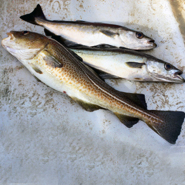Posted 23 April 2010
25% of fish products labeled and sold as cod and haddock are from different species, research shows
According to research published by the Ecological Society of America, 1 in 4 (25%) of fish products labeled and sold as cod and haddock in Ireland belong to entirely different species of fish. When only smoked fish products were included in the sample, the University College Dublin scientists who completed the study claim that 8 in 10 (82%) were mislabeled under EU regulations.
The findings indicate that EU policies governing seafood labeling are not adequately implemented and enforced in Ireland and the EU. Under EU law, fresh fishery and aquaculture products offered for retail sale must be labeled with an approved commercial designation, the production method used and the area where the fish were caught.
Using DNA barcoding to identify the species of fish, the University College Dublin scientists tested samples of fish products labeled as cod and haddock purchased from supermarkets, fresh fish counters and ‘fish and chip’ shops.
“We focused on cod (Gadus morhua) and haddock (Melanogrammus aeglefinus) because whitefish is the second most consumed seafood in Ireland – behind farmed salmon - and the similarities in appearance of filleted whitefish make it difficult to distinguish one species from another,” says Dr Stefano Mariani from the UCD School of Biology and Environmental Science, who led the study.
“We tested samples of fish products labeled as either ‘cod’ or ‘haddock’ from randomly selected retail outlets from within ten postal districts across Dublin. Within each district, we selected two samples from each of: two ‘fish and chip’ shops, two fresh fish counters, and four samples (two frozen, two packaged fresh) from each of two supermarkets.”
Using DNA barcoding, the scientists genetically identified that 25% of all samples (or 39 out of 156) labeled and sold as ‘cod’ or ‘haddock’ were from entirely different fish species, and were therefore considered mislabeled under EU regulations. When the sample only included smoked fish products labeled as cod and haddock, the mislabeling reached 82%.
“Consumers should be able to trust the seafood label,” says Dr Mariani, “especially when the fish products are purchased within the EU, where numerous policies relating to labeling and traceability are in place.”
According to Dr Mariani, sustained consumer deception through mislabeling may hamper efforts towards the recovery of depleted cod stocks.
“Accurate seafood labels can encourage sustainable industry operation, by assisting consumers in correctly identifying products and their origins, allowing them to make informed, responsible purchasing decisions.”
“The high levels of cod mislabeling found in Ireland gives a false perception of market availability, allowing consumers to believe that because cod is so widely available, the stocks must be healthy.”
The research recommends that the responsibility for enforcing seafood labeling and traceability standards in Ireland be assigned to one national agency. At present, three or more Irish government agencies are involved in the area of seafood labeling in Ireland.
“Provided they are adequately enforced, policies governing seafood labeling should assist in the monitoring of industry operation, encourage high food-safety standards, help prevent fraud for economic gain, facilitate conservation efforts, and help avoid illegal, unreported and unregulated fishing products from reaching consumers,” concludes Dr Mariani.
The problem of seafood mislabeling has recently been brought to public attention in North America. This study demonstrates that this issue is also present in the EU.
The EU is one of the world’s largest producers and importers of seafood products. In 2007, the EU produced 6.5 million tonnes (live weight) and imported almost €16 billion of fishery products.
The full scientific article entitled: “Smoke, mirrors and mislabelled cod: poor transparency in the European seafood industry” was published in Frontiers in Ecology and the Environment, a journal of the Ecological Society of America on Thursday 22 April 2010.
(Produced by UCD University Relations)

